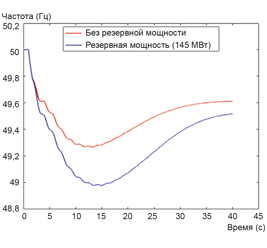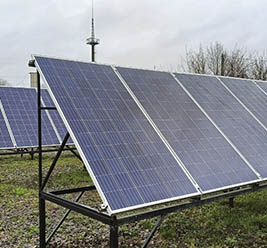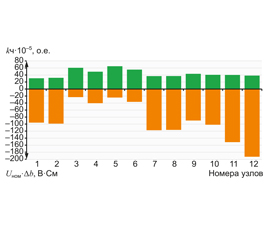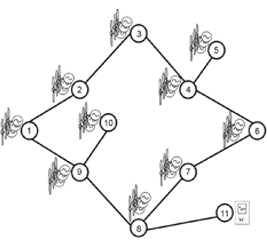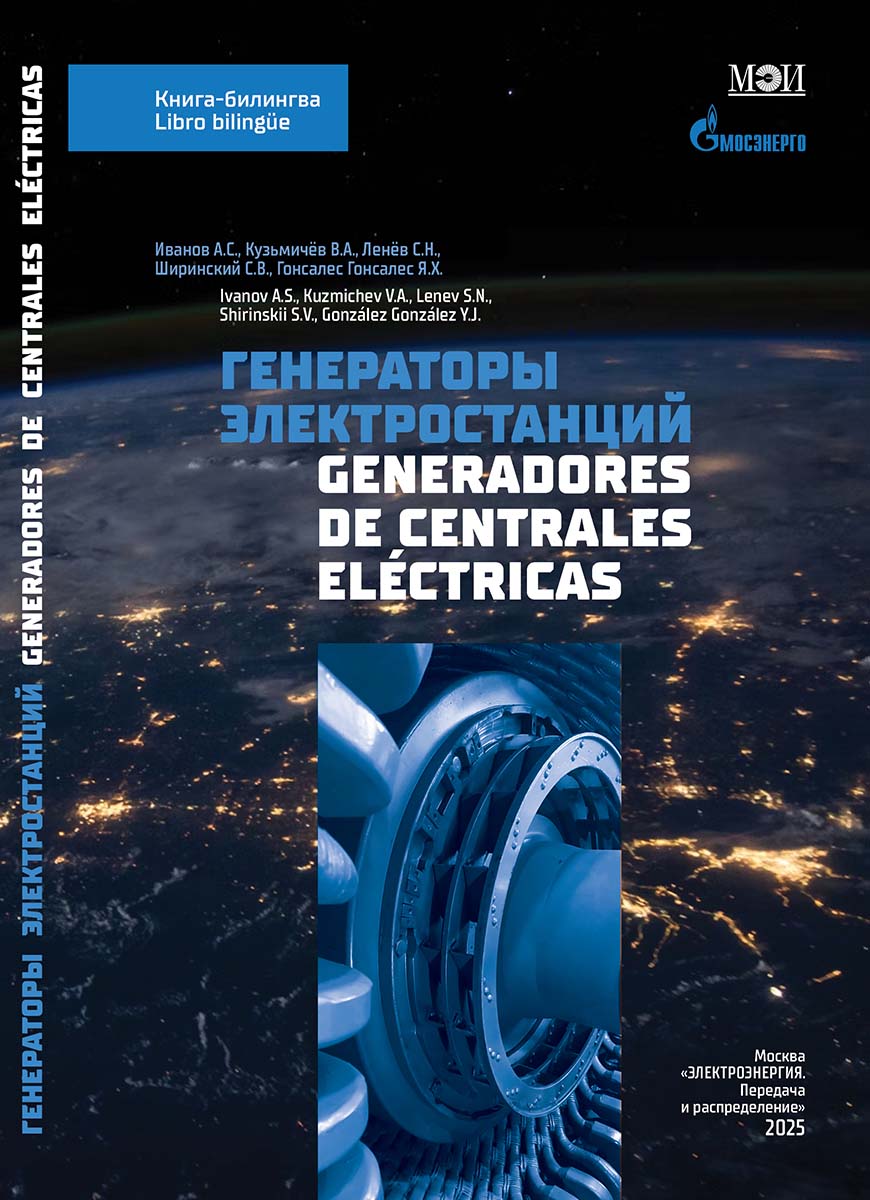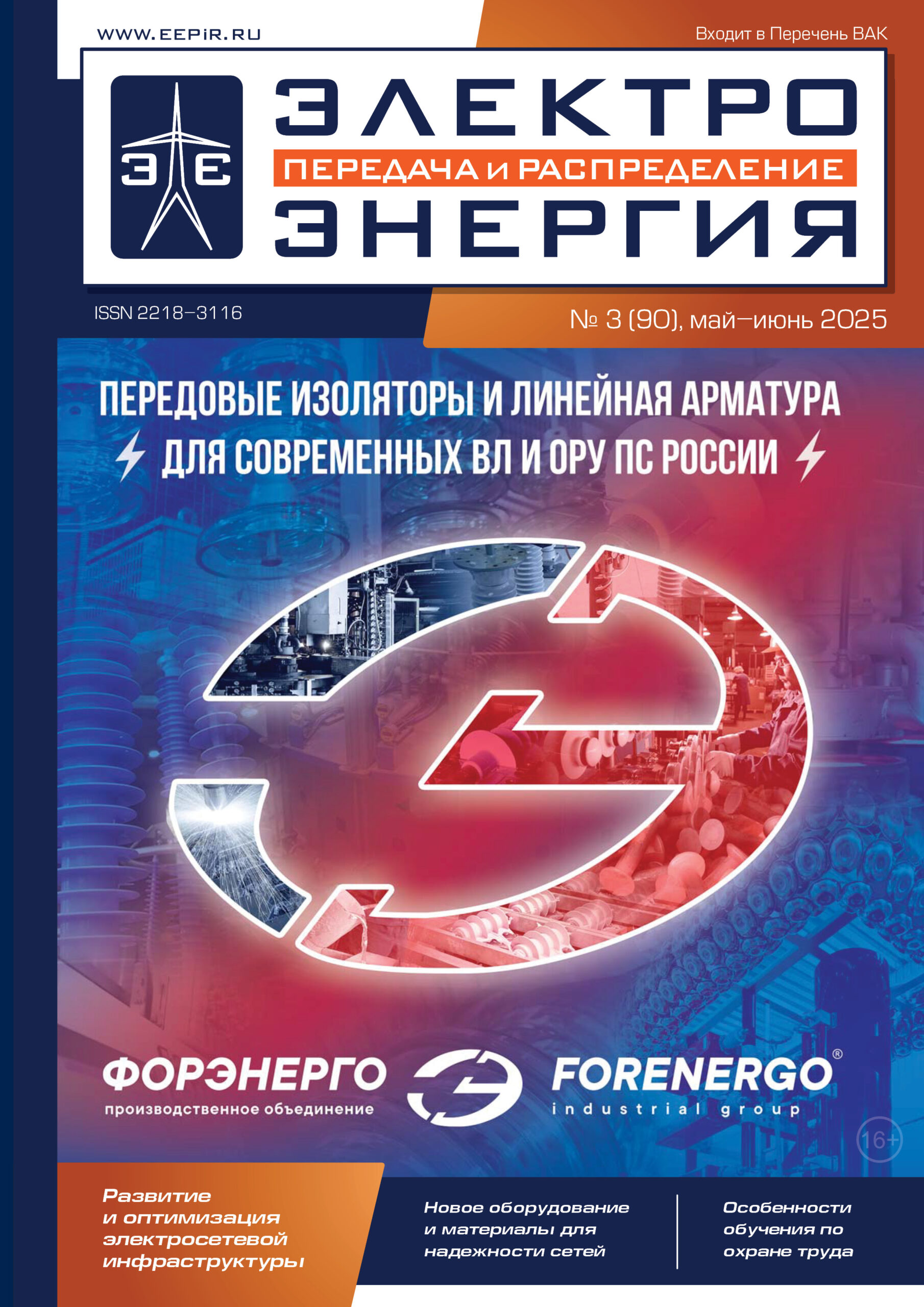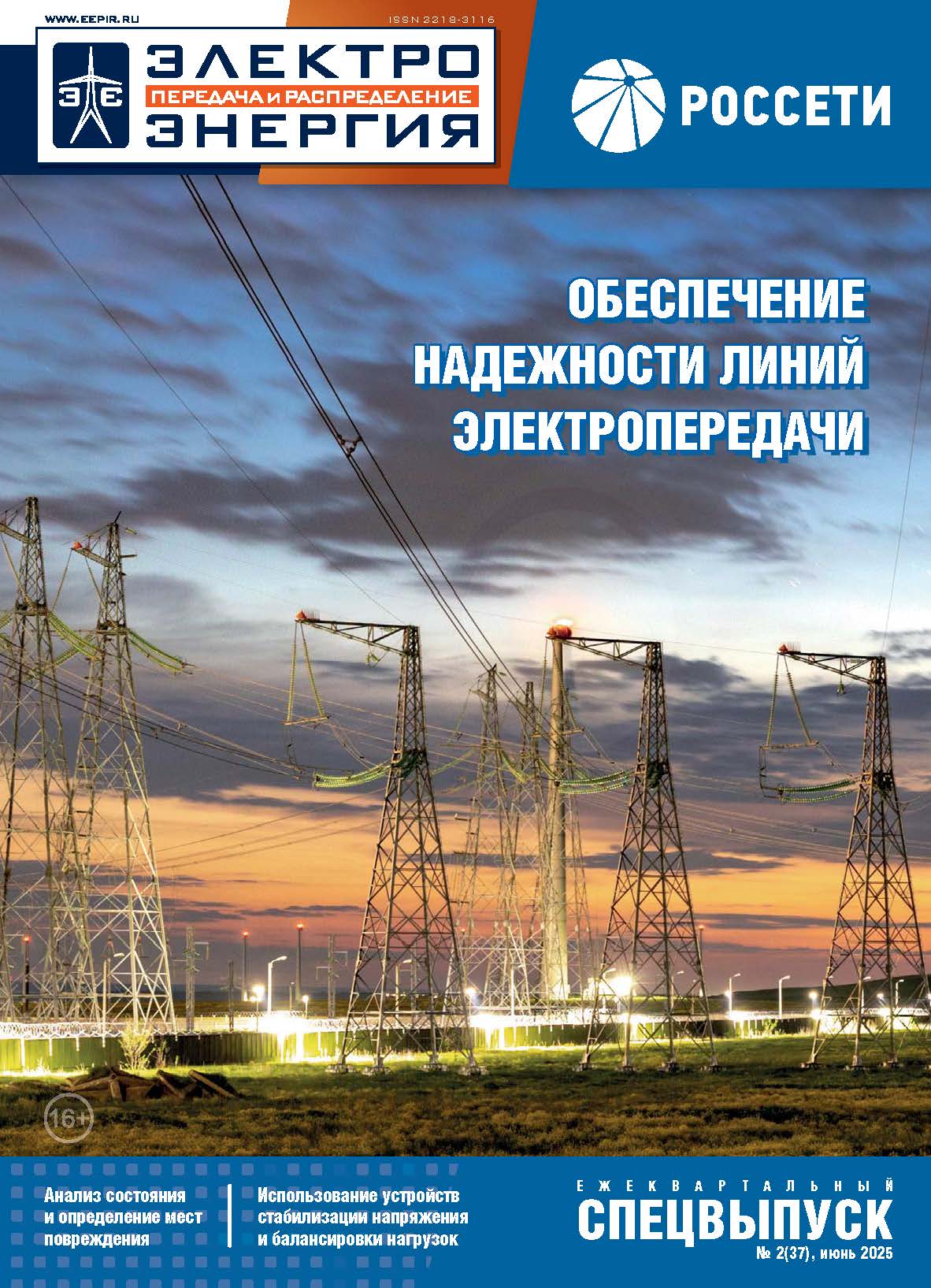
The MAIN JOURNAL for POWER GRID SPECIALISTS in RUSSIA

56
August 25–29, France, Paris
“Childhood Diseases” of
SmallScale Power Generation
Construction of small-scale generation facilities with their connection to public
distribution grids has recently become a world-wide trend, which is actively promoted
by government programs on “green energy” development. However, with all advantages
of renewable energy sources, their connection to the energy system in long term aspect
still arouses many questions. For instance, lately in the energy community one can
frequently hear experts airing concerns about the fact that wider integration of small-
scale and distributed generation facilities creates dif
fi
culties in controlling energy system
operation and ensuring system reliability, as, comparing to conventional generation,
such energy facilities are much less sustainable.
Maria RODIONOVA (
Мария
РОДИОНОВА
)
S
mall-scale and distributed power generation
issues were raised during a round-table discussion
between JSC “System Operator of Uni
fi
ed
Energy System” (JSC “SO UES”) and Russian
National Committee of CIGRE (RNC CIGRE) that took
place in Moscow. The event was attended by Russian
and foreign specialists, experts and scienti
fi
c community
representatives. The main topic of the discussion was
integration of small-scale and distributed generation in the
electric energy system.
CHARACTERISTIC FEATURES
Andrey Pazderin, Doc. of Tech. Sc., Head of the
Department “Automated Electrical Systems”, Ural Power
Engineering Institute of Ural Federal University, spoke on
the characteristics lying in the basis of classifying a power
generation facility as “small-scale”. According to him, to
be classi
fi
ed as a small-scale generation facility, it should
be located in close proximity to the place of electric
(thermal) power consumption and have installed capacity
of not more than 25 MW. In accordance with Russian
energy legislation and established practices, such facilities
do not participate in electric power wholesale market
operation and, as a rule, are owned not by a wholesale
generation company or a territorial generation company,
but by consumers or small independent generation
companies.
In most countries of the world the term “small-scale
generation” is not widely used, in distinction to the term
“distributed generation”. In accordance with CIGRE
criteria, distributed generation is
generation connected to a distribution
grid at medium (up to 30 kV) and low
(less than 1 kV) voltages. In practice,
distributed generation facilities are
those with small installed capacity,
including facilities that use renewable
energy resources: internal combustion
installations, wind generation facilities,
photovoltaic installations (solar panels),
biomass power stations, micro-turbines,
energy accumulators and other power
facilities. However, such facilities, in
case they are connected to a HV grid
(over 69 kV), cannot be called distri-
buted generation. For this reason, for
example, large-scale wind farms and
Integration of Renewable

57
info@eepr.ru, www.eepr.ru
Source: Branan
Denmark
Canada
World
China
USA
Russia
Brazil
52,3
13,5
12,5
11,1
8,1
5,7
3,7
Hydro power plants
Wind energy
Bio thermal power plants
Solar photovoltaics
Geo thermal power plants
CSP
Ocean power plants
970
238
72
70
0,5
1,8
11,2
solar panel
fi
elds, according to CIGRE
criteria, do not belong to distributed
generation. Also, the professional
community widely implements the
term “small-scale power generation”,
which has caught on as regards small-
scale generation facilities operating
according to the principle of cogeneration
(electricity and heat generation) and
trigeneration (power, heat and cooling),
which increases the ef
fi
ciency coef
fi
cient
of such installations to 80% and above.
PRACTICES ABROAD
Small-scale generation growth rates in
foreign countries are high. Yury Kucherov,
Doc. of Tech. Sc., Head of Department of
Technical Regulation of JSC “SO UES”,
member of Technical Committee of RNC
CIGRE, mentioned, among general world
trends, the growth of total installed capacity
of small-scale and distributed generation
facilities in energy systems of developed
countries, an increase of installed capacity
of single facilities of wind power stations,
development of large-scale wind farms
and solar power stations. The leader in
this
fi
eld is Germany, which has taken the
decision to abandon atomic power stations,
where now the total installed capacity of
operating photovoltaic installations makes
up as much as 33 GW, while that of wind
installations — 32 GW. In Japan the total
installed capacity of small-scale and
distributed generation amounts to about
36 GW, while in Italy — 20 GW. In the
USA there has been a signi
fi
cant growth
since 2010, and small-scale generation has
increased from 2 to 12 GW.
Yury Kucherov provided an illustrative
example of Denmark, where the share of
small-scale and distributed generation in
the volume of electric power generation
exceeds 50%. By 2020 Denmark plans to
supply 33% of its demand by means of
renewable energy sources, and by 2050
to completely opt out of generation based
on the use of organic fuel. At present,
nine large-scale wind farms with the
total capacity of about 3.5 GW and more
than four thousand wind installations,
the capacity of which exceeds 2.2 GW,
operate in the country (Fig. 1).
Programs of renewable energy
development have been developed and
approved of in more than a hundred
countries of the world (Fig. 2). The
need in development of renewables is justi
fi
ed by such factors as power
consumption growth, limited character and irregularity of location of world
reserves of fossil organic energy resources, need in reducing dependence
on import of energy resources, constant growth of prices for energy
resources, electric power and heat. In many countries emphasis is made
on development of wind and solar generation due to relatively greater
availability of these resources, though such facilities as, for example, hydro
and geothermal power stations, have a signi
fi
cantly higher coef
fi
cient of
installed capacity use than wind installations and solar panels.
Analysts’ quantitative forecasts vary, but analysts are sure that, in case
of continuous development of renewables at the same high rates as we
Fig. 1. Share of distributed generation in the total electric
power generation volume in the world, 2011, %
Source: Branan
Fig. 2. Renewable energy installed capacities in the
world, 2011, GW
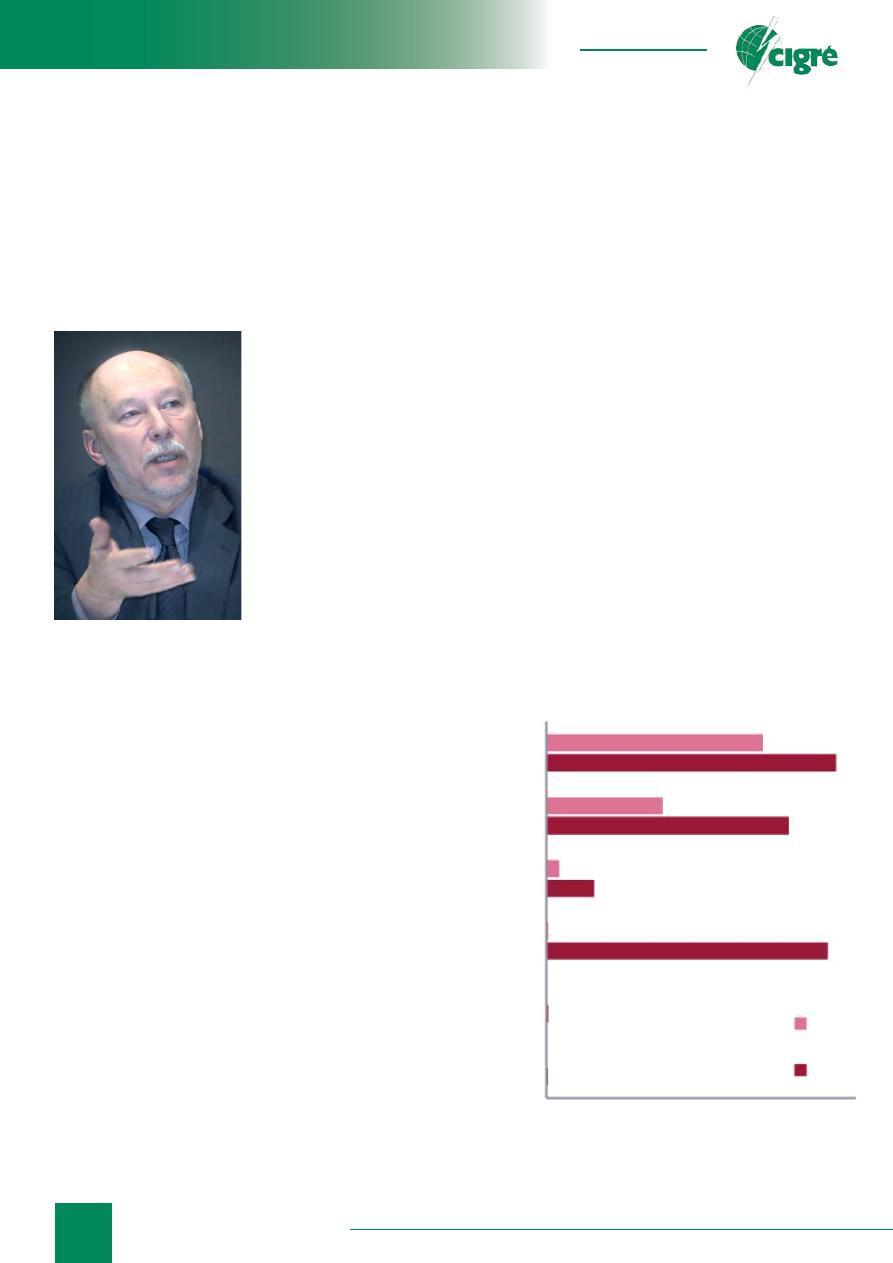
58
August 25–29, France, Paris
Yury Kucherov
Yury Kucherov
(
Юрий
Кучеров
)
(
Юрий
Кучеров
)
Source: Main directions of state policy in the sphere
of improving energy ef
fi
ciency of power industry based on
renewable sources of energy for the period up to 2020
BioTPP
Small-scale
HPP
GeoTPP
Wind farms
Tide power
plants
Solar power
plants
1400
1870
750
1567
85
2
0
2010
15
311
14
13
0
500
1000
1500
2000
2020
1817
have now, by the second half of XXI century renewable
energy will occupy signi
fi
cant positions in the energy
balance. According to IEC, the ratio of various sources
in electric power generation in the world by 2050 will be
the following: coal and gas — 25% each; atomic energy
— 18%; hydro energy — 15%, other renewables — 15%.
According to the European Renewable Energy Council,
by 2040 the share of renewables in EU will exceed 47%
of electric power generation; Shell Corporation analysts
assume that by 2060 the indicator in Europe will stay
within 60—70%.
Yury Kucherov spoke
to participants of the event
about the new
fi
eld of
implementation of small-
scale and distributed
generation which has
formed abroad —
Smart City projects.
Implementation of such
projects is directed at
ensuring people’s high
level of life through
innovative technologies in
construction, infrastructure
and everyday life.
This suggests using
such technologies as
smart waste utilization, smart energy saving, smart
transportation, etc. Within the framework of such projects
new-type generation complexes are built, which combine
distributed generation sources of various capacities and
types, as well as electric and thermal power accumulators
installed in residential and of
fi
ce buildings, enterprises.
Dozens of energy, engineering, scienti
fi
c and educational
centres participate in creation and improvement of
operation conditions of such complexes in energy systems.
Smart City projects are coordinated by public authorities.
The world has accumulated quite wide experience in
implementation of such projects, for example, “Medini
Iskandar Malaysia” (Malaysia), “Cyberjaya” (Malaysia),
“Songdo” (Korea), “Masdar City” (UAE). In Russia, April
2013 marked the start of “SMART City Kazan” project,
within the framework of which it is planned to build a
new town in 15 km from the centre of Kazan, which is
to become a business centre of the Republic of Tatarstan.
RUSSIAN REALIA
What concerns small-scale power generation, Russia
does not stay away from the general world trends,
though it has its own peculiarities. One of them is that
our small-scale generation develops mainly not through
the government’s will but at the consumers’ initiative
and without government subsidies. Consumers, mostly
industrial enterprises, consider their own generation
(including that meeting the criteria of small-scale and
distributed one) to be an ef
fi
cient way of reducing costs
and solving problems related to connection to power
grids. Another important peculiarity of Russian small-
scale generation is that small-scale generation facilities
in Russia mainly operate using organic hydrocarbon fuel
— natural, lique
fi
ed or oil-associated gas, diesel fuel
and mazut, while abroad they are created on the basis of
renewables (Fig. 3). All these Russian peculiarities can be
explained by a number of factors enumerated by Andrey
Pazderin.
Firstly, it is a lower, comparing to conventional
generation, price for electric power, due to reduction of
its grid component and fuel costs, as often fuel is a by-
product of basic production. For example, In Sverdlovsk
Region the cost of 1 kW•h, produced with the use of their
own generation sources, amounts to 1.5—2.5 rubles, with
6 rubles per 1 kW•h — with the use of external sources.
Secondly, consumers are motivated to create their own
generation facilities by annual increases of electric power
cost in the country. According to Rosstat, during the recent
3 years the average annual growth of tariffs for electric
power has amounted to 14%, said Andrey Pazderin.
Thirdly, small-scale generation development is given
impetus by general growth of demand for electric power.
Demand for electric power across the UES of Russia by
the end of 2019 is estimated to be at the level of 1151
billion kW•h, which is 134.5 billion kW•h more than
the power consumption level of 2012. The increase with
respect to the level of 2012 is estimated as 13.2%. Such
Fig. 3. Renewable energy installed capacities in
Russia, MW
Integration of Renewable

59
info@eepr.ru, www.eepr.ru
Andrey Pazderin
Andrey Pazderin
(
Андрей
Паздерин
)
(
Андрей
Паздерин
)
data are speci
fi
ed in the newest variant of the Pattern and
program of development of the Uni
fi
ed Energy System
of Russia for 2013—2019, approved by the Ministry of
Energy of Russia in July of 2013.
Another important factor of small-scale generation
development, according to Andrey Pazderin, is recent
formation of a respective technological basis — simple,
rather reliable, ef
fi
cient, ecological and relatively
inexpensive facilities for electric and thermal power
generation in volumes required by certain consumers.
Small-scale and distributed generation development
is also promoted by strengthening of ecological
requirements imposed by the state. In particular, such
an impetus was implementation of
fi
nes with respect
to oil and gas enterprises that burn associated gas in so
called
fl
ares. At present, a signi
fi
cant share of small-scale
generation facilities is integrated at oil and gas industry
enterprises that strive to solve the problem of associated
gas utilization.
However, on a whole, in UES of Russia renewable
sources of energy meet only 0.6% demand for electric
power. Weak development of renewables-based generation
mainly owes to low investment attractiveness of such
projects. According to Head of Centre of new power grid
technologies of JSC “NTC FGC UES”, Doc. of Tech.
Sc. Nikolay Novikov, there have been no attempts on
the part of the state to develop an economic mechanism
for promotion of small-scale generation, in particular,
renewables, yet. According to him, state subsidies
and economic incentives for participants of ecological
generation development projects could be included in
undertakings aimed at changing the existing situation.
RUSSIAN PROSPECTS
According to Doc. of Tech. Sc., Associate Professor
of Department “Automated Electrical Systems” of UFU,
Advisor to Director of JSC “SO UES” Petr Erokhin,
Russia has a great potential for small-scale generation
development. There are many under-populated territories,
isolated from centralized power supply, in our country.
In these areas small-scale and distributed generation
development is especially relevant as connection of
such areas to the Uni
fi
ed Energy System of Russia in the
nearest time is not economically feasible. Also, according
to him, the indication for renewable energy development
in a number of regions is weather conditions: a large
number of windy and sunny days a year, availability of
hydro-resources, etc.
Andrey Pazderin also believes that there are
natural weather and climatic conditions for renewable
energy development in Russia. Volgograd, Murmansk,
Novosibirsk Regions, Krasnodar Krai and Primorsky Krai
have prospects as regards development of small-scale and
distributed generation with the use of renewables. For
example, according to experts’ estimates, renewables-
based generation development in Kuban can provide up to
1.3 GW of electric power.
Within the framework
of the subprogram
“Development of
renewable sources of
energy for the period up
to 2020” of the federal
program “Modernization
of electric power industry
of Russia for the period
up to 2020” and in
accordance with plans
of construction of power
facilities and power plants
operating on the basis of
renewables, investment
projects providing for
construction of solar
panels with installed capacity of about 180 MW on Taman
Peninsula, as well as coast wind farms in the area of
Blagoveshchenskaya, Anapa, Gelendzhik and Eysk with
total capacity of 389 MW are ready to be implemented. A
wind power plant with total installed capacity of 5.1 MW,
a generation facility located in the territory of Kaliningrad
Region, which is unique for Russia, can be used as a good
reference point during implementation of these projects.
The wind farm located in the settlement of Kulikovo on
the coast of the Baltic Sea was commissioned in 2002. The
project was implemented with support of RAO “UES of
Russia”, administration of Kaliningrad Region, Ministry
of Energy of RF and Ministry of Environment and Energy
of Denmark. The wind power plant, consisting of twenty
one wind installations, was built with the grant of the
Danish Government.
According to Petr
Erokhin, one of promising
directions of small-scale
generation development
in Russia can be
cogeneration, which is
combined generation
of electric power and
heat, widely used in
conventional power
generation. Modernization
of existing boiler plants
up to cogeneration ones
can increase ef
fi
ciency
of power generation
installations, ensure
maximum pro
fi
table electric and thermal power supply of
consumers and reduce costs of construction of new grids
in a number of regions of the country.
NEW CHALLENGES
Specialists, experts and scienti
fi
c community
representatives say more frequently that small-scale and
distributed generation development has a great impact on
Petr Erokhin
Petr Erokhin
(
Пётр
Ерохин
)
(
Пётр
Ерохин
)

60
August 25–29, France, Paris
Integration of Renewable
operation modes of energy systems. In particular, for the
System operator, who is responsible for supervisory control
of the Uni
fi
ed Energy System, small-scale generation
development forms new conditions of supervision over
power facilities and new conditions of energy system
control.
The most important conditions of sustainable
energy system operation are constant keeping of
power generation and consumption balance, as well
as an adequate level of power accumulation in case of
unpredictable outages of power generation installations
and grid components. For these conditions to be met,
a great share of generation facilities should be capable
of dynamic power output variation (control response),
should use various kinds of fuel (fuel redundancy), be
“visible” for dispatch centres (availability of telemetry
devices), and meet a number of other requirements.
However, small-scale and distributed generation has
signi
fi
cant gaps in the
fi
eld.
Small-scale generation facilities do not have the
required control response that makes it possible to
dynamically react to changes in operating conditions and
increase quality of frequency and power
fl
ow control in the
energy system. The economically feasible operation mode
of a small-scale generation installation is continuous load
within 85—100% of the rated value; at that, the problem
of irregularity of daily power consumption patterns is to
be solved by conventional generators of the centralized
energy system, which simply cannot provide the power
balance with the existing high share of small-scale and
distributed generation because of their limited control
response capabilities.
Taking into account the fact that in Russia small-scale
generation facilities mainly use organic fuel, another
problem of their insuf
fi
cient reliability caused by no fuel
redundancy can be added. It means that power facilities
have no redundant channels of fuel supply and use one
kind of fuel only.
Besides, electric power generation by renewables-
based generation facilities depends on weather
conditions, which constantly change. Therefore, such
generation is unable to provide electric power for a long
time sustainably and regularly like conventional power
generators. That is, reliable and sustainable power
supply of consumers in various climatic situations is not
provided for.
In addition, at present there is a large number of
small-scale and distributed generation facilities that are
“invisible” for system operators, i.e. they are not equipped
with telemetry systems, enabling their visibility for control
centres.
With the existing small-scale generation development
level in Russia, these problems are still not too relevant,
but a signi
fi
cant increase of its share means that the
energy system starts to have low-response generation,
which does not participate in frequency and power
fl
ow control and requires redundancy by conventional
generation sources. To the meeting participants’ common
opinion, with a large share of small-scale and distributed
generation in the total electric power generation in the
energy system, there can arise dif
fi
culties with power
balance provision.
Yury Kucherov stated that abroad problems of
integrating small-scale generation sources in the energy
system are solved quite successfully. For example,
power accumulators, which enable smoothing of climatic
fl
uctuations, are used as an integrating link, which makes
it possible to provide reliable power supply to consumers.
In addition, new control facilities are formed in the energy
system, where various small-scale generation facilities
are combined with the aim of improving monitoring and
control. For example, these are “virtual” power plants,
which represent a number of small-scale generation
facilities in a certain territory as a single object of dispatch
control; “micro energy systems”, including various energy
sources, e.g. “smart houses” with their own generation
sources (wind generators, solar panels, diesel generators);
and “multi micro energy systems”, which combine several
micro energy systems.
Yury Kucherov underlined that at the same time solving
of the small-scale generation problem in energy systems
abroad now corresponds to the development level of this
generation, but with further increase in the number of such
energy facilities there will arise new problems mostly
connected with the growth of their impact on operation
modes of energy systems. Taking this into account, in a
number of countries, for example, in Germany and China,
regulatory authorities and professional communities
conduct active work on adjustment of existing technical
requirements to small-scale and distributed generation
facilities.
Yury Kucherov drew attention of the round-table
discussion participants to another important aspect, which
came into being due to “green energy” development,
namely economic one. Recently in a number of
countries there has arisen a con
fl
ict of interests between
conventional and distributed generation based on
renewables. Contradictions are related to state support of
renewables, which in
fl
uences redistribution of incomes of
power generation and grid companies.
TASKS TO BE
SOLVED IMMEDIATELY
With active development of small-scale and
distributed generation in conditions when precise
requirements to its operation within UES of Russia
have not been established yet there can arise dif
fi
culties
in energy system control, Petr Erokhin summarized on
the results of the round-table discussion. Nevertheless,
it is not a reason for suspending activities of consumers
wishing to build their own small-scale generation
facilities. The task of the System operator, who is
responsible for sustainable operation of the UES of
Russia, is to examine every situation, consult future

61
info@eepr.ru, www.eepr.ru
R&D tasks of small-scale
and distributed generation development
(based on the
fi
nal resolution
of the round-table discussion):
• analysis of the world experience in modelling
and development of one’s own models of
primary engines of small-scale generation
(gas-fueled reciprocating, gas turbine, CCGT
installations) and their control systems;
• research of behavior of small-scale generation
facilities in case of disturbances in the external
grid, analysis of the capability of equipment to
continue operation in case of such disturbances,
as well as specifying requirements to control
systems that improve sustainability of small-
scale generation installations;
• analysis of impact of small-scale generation on
static and dynamic energy system sustainability;
• analysis of ways to implement new technologies
(power accumulators, semi-conductor devices,
asynchronized synchronous generators,
frequency-controlled drive, etc.) for increasing
small-scale generation sustainability;
•
analysis of opportunities of autonomous
operation of small-scale generation installations
and establishment of requirements to small-
scale generation control systems to enable such
operation;
• analysis, including that of foreign experience, of
possibilities of controlling autonomous energy
systems with a large share of renewables-based
generation — wind and solar energy.
owners of small-scale generation facilities on issues
that can arise, advise them of the problems which they
will have to face while implementing their plans, and
promote development and establishment, on the state
level, of technical requirements to construction of
small-scale and distributed generation facilities and
their operation within the energy system with their
maximum efforts, he emphasized.
The participants of the meeting stated that information
provided by various international professional
organizations, especially CIGRE, which has already
accumulated a large volume of data on operation of small-
scale generation facilities in the world, as well as of the
process of standardization of technical requirements to
distributed generation sources in different countries, can
be useful in the process of development of regulations and
technical requirements in Russia.
According to the participants of the round-table
discussion, a concept and standards specifying
requirements to small-scale generation for its sustainable
operation within energy systems should be developed in
Russia in the nearest time. Andrey Pazderin emphasized
that this requires mathematical modeling for preliminary
analysis of the impact of small-scale generation on the
energy system in normal, emergency and post-emergency
modes, specifying ways to solve R&D and organizational
problems of connecting small-scale generation
installations to power grids and their operation, developing
standard technical speci
fi
cations and requirements for
such installations.
Russia is a country with special conditions: cold
climate and large distances. Therefore, according to the
participants of the meeting, a special role in successful
development of small-scale generation should belong
to pilot projects implemented in different regions of
the country with account for local peculiarities, as well
as Russian characteristics in heat generation sector, in
particular, availability of a large number of boiler plants,
which could be used for electric power generation.
Implementation of pilot projects will enable developing
required standards and typical “road maps” specifying the
strategy of development in this
fi
eld.
Small-scale generation development also requires
training of highly quali
fi
ed personnel for designing and
operation of small-scale generation facilities. During
the meeting representatives of the Russian National
Committee of CIGRE spoke on the need in developing
research and educational competences in higher
educational establishments in the
fi
eld of small-scale
generation, while using the mechanism of distribution of
R&D papers developed by RNC CIGRE in 2013.
A number of tasks the scienti
fi
c community is to solve
in connection with small-scale and distributed generation
development in Russia has been speci
fi
ed based on the
results of the meeting. They are related primarily to
dif
fi
culties in energy system control connected with small-
scale generation development and inadequate attention
to problems of operation of small-scale generation
installations.
Head of C6 “Distribution Systems and Dispersed
Generation” Subcommittee of RNC CIGRE, Cand. of
Tech. Sc., senior lecturer of Department “Automated
Electrical Systems” of UFU Pavel Chusovitin spoke
to the participants of the meeting about the program
of RNC CIGRE C6 Subcommittee activities for 2014.
He underlined that the document had been drawn with
account for the R&D tasks established during the
discussion.
Оригинал статьи: “Childhood Diseases” of Small Scale Power Generation
Construction of small-scale generation facilities with their connection to public distribution grids has recently become a world-wide trend, which is actively promoted by government programs on “green energy” development. However, with all advantages of renewable energy sources, their connection to the energy system in long term aspect still arouses many questions. For instance, lately in the energy community one can frequently hear experts airing concerns about the fact that wider integration of small scale and distributed generation facilities creates difficulties in controlling energy system operation and ensuring system reliability, as, comparing to conventional generation, such energy facilities are much less sustainable.




